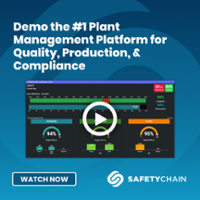The Basics of OEE: What It Is, and Why You Need It
Many plants are looking for ways to create more efficient processes and develop strategies to better compete with others in the industry. For many, this desire to improve means moving away from traditional manufacturing. It can be a little uncomfortable to look for ways to change when things seem to be working just fine already. However, sticking with processes because “that’s the way we’ve always done them” can work against driving continuous improvement. That’s where implementing OEE comes in.
What Is OEE?
OEE stands for Overall Equipment Effectiveness. Seiichi Nakajima, the father of Total Productive Maintenance (TPM), developed the term for OEE in the 1960s and later published his system in 1982. But the term is a little misleading. OEE is not just the effectiveness of a plant’s equipment—it’s so much more.
Think about OEE this way: OEE is like that shirt in your closet you love to wear to a party or special event because it fits well and feels good. But when you get home, more often than not, that special shirt goes into the closet and doesn’t reappear until you go to the following special event. You can—and should—make OEE a shirt you wear regularly. Let’s break it down.
What Is OEE in Manufacturing?
So if OEE isn’t only about equipment effectiveness, what else does it entail? OEE is measuring the overall team that is working to produce your product. It typically doesn’t involve indirect operations, but it could. Whether a facility keeps the calculations simple or makes it more complex, OEE is about identifying the percentage of planned production time that is genuinely productive. A score of 100% is perfection: the facility is only producing good parts, never has downtime, and processes are working as quickly as possible.
Is OEE the Same as Measuring Efficiency?
Efficiency is people-focused and often expressed as standard hours earned to hours worked. But only gauging efficiency can create hiding places for problems and doesn’t promote the teamwork that many facilities are looking for. Measuring efficiency alone does not always reveal where the opportunities are. OEE can take other resources into account, like indirect labor, services, or supplies.
Efficiency is doing things the right way; effectiveness is doing the right things.
You can do both, but it’s crucial to know the difference.
So What’s a Good Way to Measure OEE?
When determining OEE, we want to capture data to understand what we’re doing and why. For example, do you do preventive maintenance during the shift or outside regular hours? What are the costs and benefits? It’s crucial to remove all the hiding places and be realistic with teams about how effectively we’re actually using our line, people, and equipment.
Here’s a basic calculation for OEE
/Availability X Performance (Efficiency) X Quality (FPY) = OEE
Remember, in this calculation, you’re multiplying three decimal numbers together. Don’t be alarmed by a low number! It’s an opportunity, not a liability. To get a truly functional OEE, you need to be honest about these terms:
Availability—This is the percentage of scheduled time the operation is available to operate, often called uptime. You should include both planned and unplanned time.
Performance—How efficient were you, and how did you do against your labor standard during uptime?
Quality—Also known as first-pass yield (FPY), you’ll be looking at the good units produced as a percentage of the total units begun. Keep it simple if you’re just starting with OEE. You can always scale up to more complicated quality measures over time.
Getting a low score when you’re just beginning to track and improve your facility’s performance is pretty standard. Rather than seeing it as a failing grade, instead, use it as a jumping-off point. You can improve with easily applied measures. It’s a great opportunity!
Honest OEE Calculations Drive Change
Some facilities shy away from OEE because often, the first honest calculations yield an uncomfortably low number. For OEE to be most effective, facilities must operate as a team with everyone involved in the process. Because it takes away those hiding spots, it can cause some friction between departments. Company culture plays a huge role in successful implementation. But by presenting OEE as an opportunity for everyone, you can bring everyone on board. Drive continuous improvement through embracing TPM, identifying and eliminating wastes, working Lean programs, and making it fun for your staff.
Gathering Data and OEE Software
Facilities typically gather OEE data in one of three ways:
Manually—Employees work spreadsheets on clipboards. Spreadsheets are valuable and accessible, but they are also labor-intensive and prone to human error when used manually.
Semi-automated—Employees key data into tablets that feed OEE software.
Fully-automated—Hardwired or wireless devices send data directly to the software.
OEE software makes data easier and so much faster to collect, and it allows you to do more analysis improvement than just churning and burning the numbers. Implementing OEE software does come at a cost, but companies can achieve ROI—return on investment—within a few months. OEE software can track OEE in several different ways to help you identify bottlenecks in real-time. Revealing issues before they escalate allows your facility to implement solutions quickly.
OEE Manufacturing Means a Mindset Shift
Make sure introducing OEE goes well—clearly outline what the goals of implementing OEE are. Remind the team that honesty and teamwork are essential. It all comes down to how you propose it. If employees view it as a critical or negative tool, they’ll resist and resent it. Using OEE requires a shift in mindset. Many hesitate to continue after seeing the initial low number, but the key is to view that number as your start on the path to driving real improvement. Remember, a low number translates to a big opportunity!
SafetyChain’s OEE software presents valuable information on an easy-to-read dashboard that can break down your OEE score based on customizable factors and viewable in several different time frames. Once you’ve gotten your OEE to your first target, you can set a goal to continue to improve OEE by a percentage each year. You’ll drive continuous improvement and build a workplace culture centered on collaboration and achievement.




